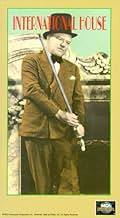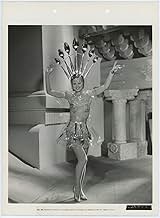NOTE IMDb
6,9/10
1,5 k
MA NOTE
Des personnages loufoques convergent vers un hôtel chinois pour enchérir sur une nouvelle invention, la télévision.Des personnages loufoques convergent vers un hôtel chinois pour enchérir sur une nouvelle invention, la télévision.Des personnages loufoques convergent vers un hôtel chinois pour enchérir sur une nouvelle invention, la télévision.
Rose Marie
- Rose Marie
- (as Baby Rose Marie)
Histoire
Le saviez-vous
- AnecdotesDuring the filming of one of W.C. Fields' scenes, a mild earthquake struck Los Angeles. The earthquake was supposedly captured on film. In the film clip, Fields and his co-stars are standing in the hotel lobby set, when the picture begins to shake as if the camera is vibrating. A chandelier on the set begins to swing back and forth, and a lamp suddenly falls over. Fields calmly ushers his co-stars off the soundstage, telling them to stay calm and walk slowly. The "earthquake footage" of Fields was played in newsreels across the country in the weeks following the 1933 quake. Nearly forty years later, however, director A. Edward Sutherland admitted that the "earthquake footage" was a hoax concocted by himself and Fields. It was done by rigging wires on the lamp and chandelier, and shaking the camera to simulate an earthquake. Sutherland claimed that he and Fields were amazed when the "earthquake footage" was accepted as genuine by newsreel distributors. "We shared a big laugh and an even bigger drink", Sutherland recalled. To this day, the fake "earthquake footage" is occasionally broadcast and accepted as genuine by entertainment television shows such as Access Hollywood (1996). The footage appeared in Hollywood Graffiti (1983).
- GaffesDuring the scene where Prof. Henry R. Quail is by his auto gyro talking to Doctor Wong and Peggy Hopkins Joyce, you can see the shadow of the boom mic moving above their heads. The boom mic then hits something, presumably the auto gyro, making a noise which makes Prof. Henry R. Quail and Peggy Joyce look up.
- Citations
Professor Quail: Hey! Where am I?
Woman: Wu-Hu.
Professor Quail: Woo-Hoo to you sweetheart. Hey Charlie, where am I?
Hotel Manager: WU-HU!
[Professor Quail removes the flower from his lapel]
Professor Quail: Don't let the posey fool you!
- ConnexionsFeatured in Oops, those Hollywood Bloopers! (1982)
- Bandes originalesShe Was a China Tea-cup and He Was Just a Mug
(1933) (uncredited)
Lyrics by Leo Robin
Music by Ralph Rainger
Sung offscreen by an unidentified man and danced by Sterling Holloway, Lona Andre,
Mary Jane Sloan, Gwen Zetter and Chorus
Commentaire à la une
Paramount had the brilliant idea of featuring radio in the movies the previous year with The Big Broadcast. That film featured all kinds of radio stars the public only imagined and had an anarchic plot similar to International House.
I've often wondered if Paramount didn't mean to have this be The Big Broadcast of 1933 originally. Repeating from the cast of The Big Broadcast are Stu Erwin and Burns & Allen and Cab Calloway. Adding to the general hilarity are W.C. Fields, Franklin Pangborn, Rudy Vallee, Bela Lugosi, and the Paris Hilton of her day, Peggy Hopkins Joyce.
The slender thread of a plot this movie hangs on involves a Chinese inventor Edmund Breon who invents the seeing eye, radio you can see as well as listen to. Everyone wants to get their hands on this valuable patent. A lot of the musical guest stars get hooked into the film via the inventor testing out the device.
Bing Crosby made his feature film starring debut in The Big Broadcast and I wonder why his crooning rival Rudy Vallee was hired for this film. Rudy has a nice, but unmemorable number.
Of course what makes the film really go are Burns and Allen and W.C. Fields. They uplift any film they are in. George and Gracie's montypythonesque type dialog is timeless and priceless.
So is Fields of course, the eternal misanthrope. There was one bit of humor I caught in International House though that is rather dated. During that final chase scene through the International House lobby with Fields in an automobile, he pokes his head through the car roof and puts his top hat on. He then remarks something about this car used to belong to the Postmaster General.
As it turns out Herbert Hoover's Postmaster General was a rather fatuous gentlemen named Walter Brown. He liked to wear high silk hats and had a limousine designed with an extra tall roof so he could ride with his topper on. At government expense of course in the middle of the Depression. He was forever derided as High Hat Brown after that and even a year later after Hoover was out of office, W.C. Fields could wring a laugh or two with that crack from the Depression audience.
Still though, this should really be called The Big Broadcast of 1933.
I've often wondered if Paramount didn't mean to have this be The Big Broadcast of 1933 originally. Repeating from the cast of The Big Broadcast are Stu Erwin and Burns & Allen and Cab Calloway. Adding to the general hilarity are W.C. Fields, Franklin Pangborn, Rudy Vallee, Bela Lugosi, and the Paris Hilton of her day, Peggy Hopkins Joyce.
The slender thread of a plot this movie hangs on involves a Chinese inventor Edmund Breon who invents the seeing eye, radio you can see as well as listen to. Everyone wants to get their hands on this valuable patent. A lot of the musical guest stars get hooked into the film via the inventor testing out the device.
Bing Crosby made his feature film starring debut in The Big Broadcast and I wonder why his crooning rival Rudy Vallee was hired for this film. Rudy has a nice, but unmemorable number.
Of course what makes the film really go are Burns and Allen and W.C. Fields. They uplift any film they are in. George and Gracie's montypythonesque type dialog is timeless and priceless.
So is Fields of course, the eternal misanthrope. There was one bit of humor I caught in International House though that is rather dated. During that final chase scene through the International House lobby with Fields in an automobile, he pokes his head through the car roof and puts his top hat on. He then remarks something about this car used to belong to the Postmaster General.
As it turns out Herbert Hoover's Postmaster General was a rather fatuous gentlemen named Walter Brown. He liked to wear high silk hats and had a limousine designed with an extra tall roof so he could ride with his topper on. At government expense of course in the middle of the Depression. He was forever derided as High Hat Brown after that and even a year later after Hoover was out of office, W.C. Fields could wring a laugh or two with that crack from the Depression audience.
Still though, this should really be called The Big Broadcast of 1933.
- bkoganbing
- 16 juil. 2006
- Permalien
Meilleurs choix
Connectez-vous pour évaluer et suivre la liste de favoris afin de recevoir des recommandations personnalisées
- How long is International House?Alimenté par Alexa
Détails
- Durée1 heure 8 minutes
- Couleur
- Rapport de forme
- 1.37 : 1
Contribuer à cette page
Suggérer une modification ou ajouter du contenu manquant

Lacune principale
By what name was International House (1933) officially released in India in English?
Répondre



































